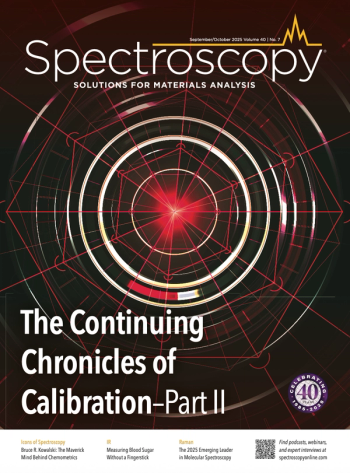
Wearable Vibrational Spectroscopy is Here For Real-Time Sensing
Key Takeaways
- Wearable vibrational spectroscopy leverages miniaturization, flexible electronics, and AI for real-time, non-invasive monitoring of physiological states.
- Key enabling technologies include flexible photonics, plasmonic sensors, AI-driven calibration, and IoT connectivity, enhancing device functionality and data security.
The miniaturization of spectroscopic instruments has reached a remarkable milestone: wearable vibrational spectroscopy. Techniques such as Raman, surface-enhanced Raman scattering (SERS), infrared (IR), and functional near-infrared (fNIRS) spectroscopy are no longer confined to the laboratory bench—they now fit on our bodies, into household devices, and onto industrial equipment. These wearable devices promise continuous, real-time monitoring, offering molecular-level insights for personal health, household management, clinical care, and industrial applications.
Introduction: From Benchtop to Skin-Patch
For decades, vibrational spectroscopy was anchored in the lab: bulky Raman units, Fourier transform infrared (FT-IR), and FT-NIR systems, and high-resolution dispersive spectrometers. Today, miniaturization, flexible electronics, plasmonic nanostructures, wireless connectivity, and AI have converged to enable wearable vibrational spectroscopy (1–22). In essence, the paradigm has shifted from bringing the selected sample to the laboratory instrument to bringing the miniature instrument to the sample (11).
This article explores the latest advances in wearable vibrational spectroscopy, highlighting key enabling technologies—flexible photonics, plasmonic sensors, AI-driven calibration, IoT connectivity, and cybersecurity—and discusses how these devices are transforming the way spectroscopists think about sampling, calibration, and real-world data collection.
Wearables technology is more than an engineering marvel; it fundamentally changes chemometrics. Continuous, mobile sampling in uncontrolled environments introduces motion artifacts, wide temperature changes, variable sampling contact, fluctuating interferents, and little opportunity for sample extraction or complex sample preparation. Concepts like the net analyte signal (NAS)—the fraction of a multivariate spectrum unique to a target analyte—become critical for maintaining specificity and robustness in the environment encountered when using wearable sensors (4,22).
Enabling Technologies: Making Wearables Work
The foundation of wearable vibrational spectroscopy lies in a confluence of enabling technologies. Flexible organic photodetectors (OPDs) and stretchable optical waveguides now allow sensors to conform to skin, joints, or textiles without compromising signal integrity (13,8). Miniaturized Raman spectrometers and wearable SERS patches integrate plasmonic nanostructures and compact electronics into wristbands or skin patches, enabling detection of biomarkers in sweat, subcutaneous blood, and other tissue or body fluids (2,7,18).
NIR and functional NIR (fNIRS) wearables extend this capability to monitoring tissue oxygenation, muscle metabolism, and even cognitive fatigue, as demonstrated by wireless headband-style fNIRS devices (5,12,14). These devices are further enhanced by smart materials and AI-driven edge computing, enabling real-time interpretation of complex spectral signals, calibration drift correction, and personalized health monitoring (6,7,20).
Connectivity via IoT or Internet of Medical Things (IoMT) devices adds both opportunity and responsibility. Hybrid Graph Convolutional Network (GCN)-transformer AI models can now detect cyberattacks on networked wearables, ensuring that sensitive spectral health data remains secure (1).
Personal Health and Consumer Applications
The most immediate impact of wearable vibrational spectroscopy is in personal health monitoring. Sweat-based SERS patches provide continuous, non-invasive measurement of metabolites, electrolytes, and hormones, capturing real-time physiological states such as stress, hydration, and metabolic function (7). Wearable NIR and Raman devices aim for non-invasive glucose monitoring, a longstanding goal that promises painless, continuous tracking (10).
Beyond chemical monitoring, wearable fNIRS sensors are beginning to track cognitive fatigue and brain hemodynamics, opening possibilities in safety-critical professions such as driving, aviation, or military operations (5). Even athletes are benefiting: NIR-based wearables monitor muscle oxygenation and metabolic response in training, informing performance optimization (12,14).
In household and consumer settings, miniaturized spectrometers are being integrated into smart kitchen appliances, robotic cleaners, and even utensils. These “embedded wearables” help monitor nutrition, detect contaminants, and optimize hydration and food quality—essentially bringing real-time chemical sensing into daily life (3,19).
Industrial, Clinical, and Environmental Applications
Wearable vibrational spectroscopy is not limited to bodies and kitchens. In industrial environments, miniaturized Raman and NIR sensors are embedded into wearable loops, helmets, or robotic arms for real-time monitoring of chemical streams, corrosion, contaminants, or machine wear (11,8). These devices integrate with industrial IoT systems and digital twins, enabling predictive maintenance and process optimization.
Clinically, ultra-miniaturized Raman and SERS wearables offer continuous monitoring of biomarkers, tissue oxygenation, and metabolism outside hospital settings (2). These devices promise decentralized care, but require rigorous calibration, standardization, and cybersecurity to ensure accuracy, reproducibility, and patient safety.
Challenges and Chemometric Considerations
Transitioning wearable vibrational spectroscopy from prototypes to practical tools requires addressing multiple challenges:
- Optical and Miniaturization Trade-offs: Reducing spectrometer size inevitably reduces optical throughput, resolution, and signal-to-noise ratio. Strategies such as SERS enhancement, waveguides, micro-optics, and AI compensation are key.
- Calibration and Specificity: Wearable sensors face variable placement, motion artifacts, environmental effects, and inter-subject variability. Net analyte signal (NAS)-based chemometrics, calibration transfer, adaptive machine language (ML) models, and background suppression are essential for meaningful results (4,22).
- Data Analytics and Edge Computing: Continuous spectra require real-time processing, baseline correction, and anomaly detection. AI models must be interpretable, generalizable, and continuously updated.
- Connectivity, Security, and Regulatory Compliance: Secure wireless transmission, authentication, privacy standards, and clinical/regulatory approval are critical, especially for IoMT devices (1).
- Device Safety: Medical electrical devices undergo rigorous safety and performance testing to ensure they are safe for patients, operators, and the environment. These tests are guided primarily by IEC 60601, the International Electrotechnical Commission (IEC) standard for medical electrical equipment. Devices are evaluated for electrical safety, and electromagnetic compatibility (EMC). Mechanical and environmental testing assesses durability under vibration, temperature extremes, and exposure to dust or water, often referencing IEC 60068 (environmental testing) and IEC 60529 (ingress protection ratings). Parts that contact patients undergo biocompatibility testing according to International Organization for Standardization (ISO) 10993 standard for biological evaluation of medical devices). Devices with software follow IEC 62304 for software lifecycle processes, while functional safety, alarms, and electrical stimulation performance are evaluated according to the IEC 60601-1-4 collateral standard (16). Other safety considerations include thermal and fire safety, often referencing Underwriters Laboratories (UL) standards for flammability. Regulatory oversight is provided by organizations such as the U.S. Food and Drug Administration (FDA) in the United States or the European Union Medical Device Regulation (EU MDR) in Europe, ensuring that all testing, risk assessment (ISO 14971), labeling, and documentation are properly conducted.
- Ergonomics and Biocompatibility: Comfort, skin safety, battery life, and wearability are as important as signal fidelity. Devices like wearable fNIRS systems demonstrate >50 hours of continuous monitoring, showing feasibility for long-term use (5).
Future Outlook: The Road Ahead
The future of wearable vibrational spectroscopy is rich with promise. Multimodal integration will combine Raman, SERS, NIR, fNIRS, and even electrochemical sensors into single wearable devices, expanding applications from health to industrial monitoring (20,21). Continuous, personalized “spectral streams” will feed predictive analytics for health optimization, early disease detection, and performance monitoring.
In industrial settings, wearables will interface with digital twins and IoT platforms, enhancing process safety, yield, and predictive maintenance. Adaptive AI and chemometric models will tailor calibration to individual users and devices, overcoming drift, motion, and matrix variability. Regulatory maturity and standardized validation will further accelerate adoption, making non-invasive metabolic monitoring and biomarker detection feasible on a large scale.
Wearable vibrational spectroscopy is no longer a futuristic concept—it is emerging as a tangible reality across health, consumer, household, clinical, and industrial domains. Enabled by miniaturized Raman and SERS spectrometers, flexible waveguides, NIR/fNIRS devices, AI-driven chemometrics, and secure IoT connectivity, these wearables bring molecular-level sensing into everyday life.
However, realizing the full potential requires careful attention to specificity, calibration, drift management, ergonomics, safety, cybersecurity, and regulatory compliance. For spectroscopists, chemometricians, and instrumentation scientists, the wearable era offers exciting challenges and opportunities: continuous, mobile molecular monitoring, adaptive calibration, and ubiquitous real-world spectroscopy. The lab is becoming mobile, the spectrometer is becoming wearable, and vibrational spectroscopy is entering the era of “everywhere analysis.” Spock’s science fiction Tricorder vision is becoming a miniature reality.
References (Click article titles for active links)
(1) Wetzel, W.
(2) BaySpec, Inc.
(3) Wetzel, W.
(4) Workman, J., Jr.
(5) Workman, J., Jr.
(6) Workman, J., Jr.
(7) Workman, J., Jr.
(8) Workman, J., Jr.
(9) Analytically Speaking Podcast, Episode 27.
(10) Workman, J., Jr.
(11) Workman, J., Jr.
(12) Chasse, J.
(13) Workman, J., Jr.
(14) Workman, J., Jr.
(15) Hroncich, C.; Workman, J., Jr.
(16) International Electrotechnical Commission. IEC 60601‑1:2005 + Amendment 1:2012 + Amendment 2:2020 — Medical electrical equipment – Part 1: General requirements for basic safety and essential performance. Geneva, Switzerland: IEC, 2020.
(17) Ocean Optics.
(18) Crocombe, R. A.; Kammrath, B. W.; Leary, P. E.
(19) Crocombe, R.
(20) Kaur, B.; Kumar, S.; Kaushik, B. K.
(21) Huck, C. W.; Grabska, J.; Bec, K. B.
(22) Workman, J., Jr.; Mark, H.
Newsletter
Get essential updates on the latest spectroscopy technologies, regulatory standards, and best practices—subscribe today to Spectroscopy.





